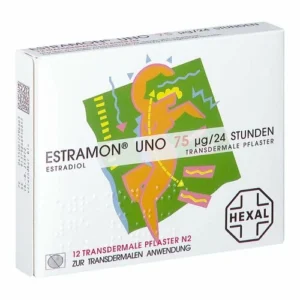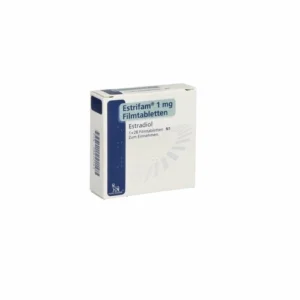Therapeutic indications
Physiological or postoperative menopause (hot flashes, sleep disorders, urogenital atrophy, mental instability, mood swings); postmenopausal osteoporosis (prevention).
Contraindications
Breast cancer and other estrogen-dependent tumors (diagnosed or suspected), endometriosis, vaginal bleeding of unknown etiology; severe kidney, liver, cardiovascular diseases; thromboembolism and thrombophlebitis (including history), pregnancy, childhood.
Pharmacodynamics
The active substance of Estramon, synthetic 17β-estradiol, is chemically and biologically identical to endogenous human estradiol produced in a woman’s body by the ovaries, starting with the first menstruation and up until menopause. Estrogens form a complex with specific receptors found in the cells of various target organs – the uterus, vagina, urethra, mammary gland, liver, hypothalamus, pituitary gland. The receptor-ligand complex interacts with estrogen-effector elements of the genome and specific intracellular proteins that induce the synthesis of mRNA, proteins and the release of cytokines and growth factors.
It has a feminizing effect on the body. It stimulates the development of the uterus, fallopian tubes, vagina, stroma and ducts of the mammary glands, pigmentation in the nipples and genitals, the formation of secondary sexual characteristics of the female type, the growth and closure of the epiphyses of long tubular bones. Promotes timely rejection of the endometrium and regular bleeding, in high concentrations causes endometrial hyperplasia, suppresses lactation, inhibits bone resorption, stimulates the synthesis of a number of transport proteins (thyroxine-binding globulin; transcortin; transferrin; SHBG), fibrinogen. Has a procoagulant effect, increases the synthesis of vitamin K-dependent blood coagulation factors in the liver (II, VII, IX, X), reduces the concentration of antithrombin III.
Increases the concentration of thyroxine, iron, copper in the blood. Has an anti-atherosclerotic effect, increases the content of HDL, reduces LDL and cholesterol, increases the concentration of triglycerides. Modulates the sensitivity of receptors to progesterone and sympathetic regulation of smooth muscle tone, stimulates the transition of intravascular fluid into tissues and causes compensatory retention of sodium and water. In high doses, it prevents the degradation of endogenous catecholamines by competing for active receptors of catechol-O-methyltransferase.
After menopause, only a small amount of estradiol is produced in the body (from estrone contained in the liver and adipose tissue). A decrease in the level of estradiol produced by the ovaries is accompanied in many women by vasomotor and thermoregulatory instability (flushes of blood to the skin of the face), sleep disorders, and progressive atrophy of the mucous membrane of the genitourinary system.
Due to estrogen deficiency, osteoporosis develops (mainly of the spine). After oral administration, most of the estradiol is metabolized in the lumen (microflora) and wall of the intestine, as well as in the liver (which leads to non-physiologically high concentrations of estrone in the plasma, and with long-term therapy – to the accumulation of estrone and estrone sulfate). The consequences of accumulation of these metabolites in the body over a long period of time have not yet been studied. It is known that oral administration of estrogens causes an increase in protein synthesis (including renin), which leads to an increase in blood pressure.
Causes moderate proliferation of the endometrium and improves the trophism of the genitourinary system. Estradiol plays an important role in bone metabolism and thus prevents the development of osteoporosis. By affecting the hypothalamic-pituitary system, it eliminates vegetative-vascular and psychoemotional disorders.
Warning: Always consult a doctor before using medications.












